This pineapple topping recipe makes a very easy fruit topping. Loaded with tiny chunks of juicy pineapple, this topping is also quick to make and perfect for cakes and other desserts.
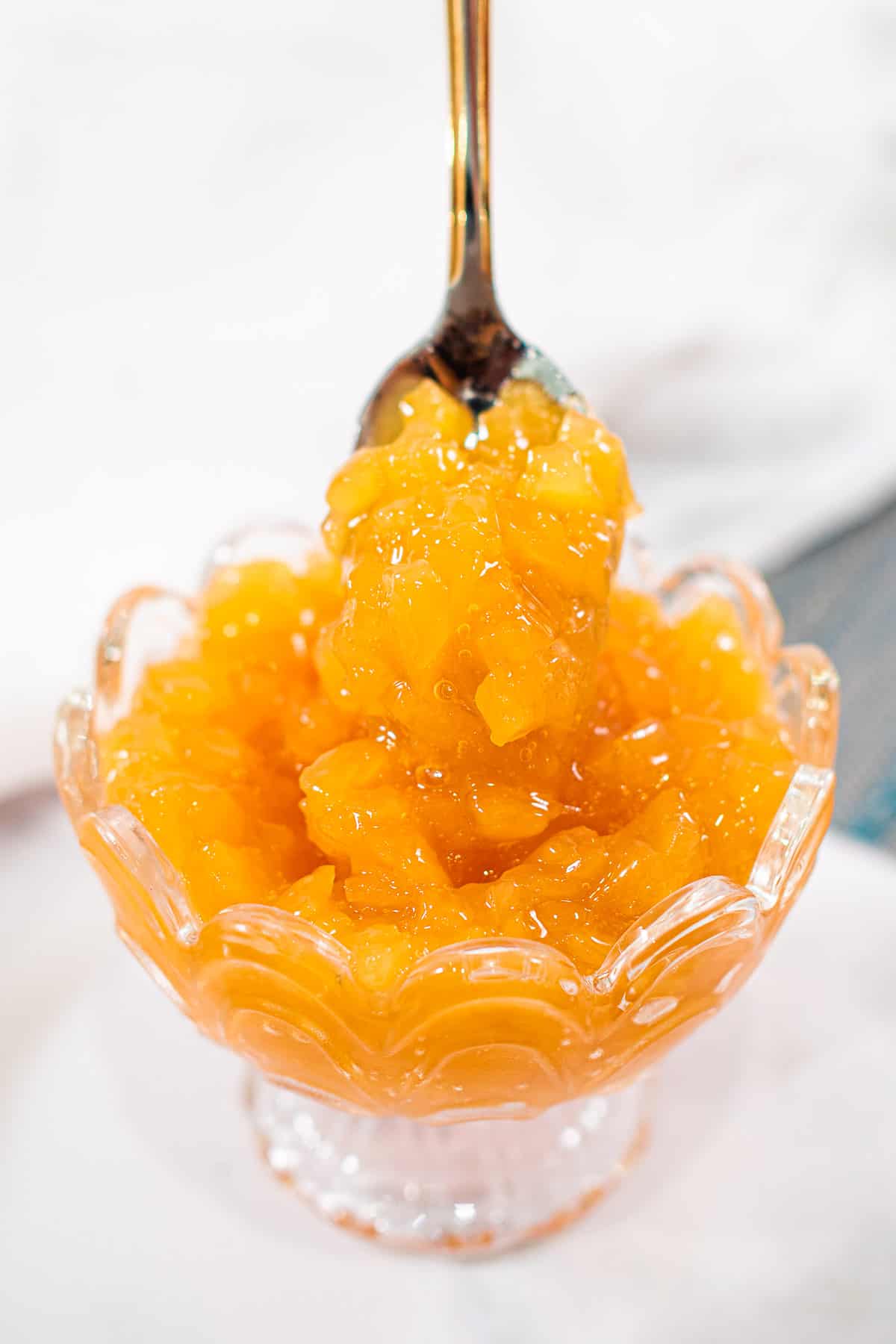
I have another recipe for pineapple filling which is pretty much similar to this topping recipe, except that I choose to make that filling without any chunky fruit pieces in it.
Smooth fillings work better for desserts like cheesecakes that require cutting (like my baked pineapple cheesecake here). Chunky fruit pieces in the cheesecake can make it difficult to cut neat pieces, hence my preference for a smoother filling in such treats.
Jump to:
❤️Why you will love this recipe
- This is an easy recipe. It can be made using both fresh and canned pineapple, making it flexible enough to be made even when fresh fruits are not available.
- This pineapple topping recipe requires only 5 ingredients – pineapple, sugar, water, lemon juice and cornstarch. All these ingredients are very basic pantry supplies except for pineapple. And even if fresh pineapple is not readily available, it can be easily substituted with canned pineapples which can be easily obtained.
- This is a very versatile topping recipe. It is great on cakes, cupcakes, pancakes, ice creams, and many other treats. And despite calling this a topping recipe, it is also great as a filling, especially for individual-sized treats like mini cheesecakes.
Like this recipe? Here are my other posts you might want to check out:
📋Ingredients
- Fresh or canned pineapple - if using fresh pineapple, use a well ripened fruit. For canned pineapple, you can use either crushed pineapple, pineapple cubes or pineapple rings.
- White sugar - both coarse sugar or granulated sugar will work for this recipe.
- Cornstarch (mixed with some water) - cornstarch tend to be lumpy. It is best sifted before using.
- Lemon juice - Use fresh lemon juice and strain it to remove any seeds or pulps.
- Water ( and pineapple syrup if using canned pineapple) - use filtered water.
*Refer to the recipe card below for full list of ingredients and exact quantities. For best results, use a digital kitchen scale where applicable*
🧾Substitution and Variations
- This pineapple topping is made using white sugar. You can always substitute it with brown sugar is you wish. Substitute with the same amount. Do take note that brown sugar will result in your pineapple topping to be of a brown hue and white sugar will keep it yellow.
This recipe has not been tested with other substitutions or variations. If you do try, please let me know in the comments section below!
👩🍳How to Make
Preparing the pineapple
Option 1: Fresh pineapple - peeling & processing
- If you plan on making this topping with fresh fruit, start by preparing the pineapple first. Peel and chop it into small cubes. Not sure how to peel a fresh pineapple? Check out my detailed, step-by-step tutorial on how to peel a pineapple (including a video tutorial here).
- The next step is to chop the pineapple into tiny pieces. You can do this in a food processor or by hand. In a food processor, pulse the fruits until they are all chopped roughly. There is no need to blend until smooth. Suffice if they look like crushed pineapple.
- If cutting by hand, chop them into as small pieces are you wish.
Option 2: Canned pineapple (crushed pineapple, pineapple cubes and pineapple rings in syrup) -Processing the pineapple
- Place the pineapple cubes into a food processor. If using pineapple rings, chop them into smaller pieces first. Pulse until the pieces are chopped into smaller pieces.
- If you are using crushed pineapple, there is no need to chop them further.
Cooking the pineapple topping

- Once the fruit is all prepared, transfer the chopped fruit into a medium saucepan.
- Add the sugar, lemon juice, and water.
- Stir and cook them over low to medium heat. The mixture will appear runny initially.
- Turn the heat to low and let the topping simmer slowly to allow the chopped pineapple to cook. As it starts to thicken, keep stirring to avoid it from burning.
- Mix corn starch with some water. Pour it into the pineapple topping mixture. Stir quickly and thoroughly to avoid clumping.
- Continue to cook until the topping thickens up. Once it reaches your desired consistency, turn the heat off. Let it cool before transferring it into a clean container. Keep refrigerated until ready to use.

🍽️Serving & storage
- Given that this is a fruit topping and there are no preservatives in it, it should be kept refrigerated if not used immediately. It can last in the refrigerator for a good 4 to 5 days. Store it in an airtight container or clean mason jar to avoid it from becoming dry and absorb the odor in the fridge.
- The topping can also last longer if it is frozen. You can freeze it for up to 2 months. Thaw it completely before using.
💡Expert Tips
- The taste of canned pineapple is more consistent as they are soaked in sugar syrup compared to fresh pineapple. If you are using fresh pineapple, choose a fruit that is well ripened. A not-so-well ripe fruit will be more sour and taste somewhat bland.
- Regardless of whether you are using fresh pineapple or the canned version, pineapple chunks do not generally soften easily with cooking. Hence you will notice that I have used quite a lot of liquid (water or syrup) in making this fruit topping. The water helps the fruits simmer longer and that helps to soften them better.
- Fresh pineapple is often a lot firmer compared to the canned version. Hence, given the same cooking time, you will find that the topping made using canned pineapple is softer than that made using fresh pineapple.
- There is no difference in the amount of sugar used for the topping made with fresh pineapple and canned pineapple. Despite the canned pineapple being soaked in sugar syrup, it still requires sugar to be added to it when making the topping for best results.
- Cornstarch slurry (mixture of cornstarch and water), if not used immediately will cause the cornstarch to settle into a layer at the bottom of the container. Mix it properly again before using.
⭐What can you use the pineapple topping for?
Here is what you can use this delicious pineapple topping for:
- Spoon over a scoop or two of vanilla ice cream for a classic and tropical flavored ice cream or banana split.
- Spoon over pancakes or waffles for a tropical twist to your breakfast.
- Layer with yogurt and granola in a glass or bowl to create a vibrant and flavorful parfait.
- Spread on toast, bagels, or English muffins for a whole new way of adding some tropical twist to your morning meal.
- Use pineapple as a filling for cakes, cupcakes, or muffins.
- Add to a green salad or fruit salad. It pairs well with fresh fruits, leafy greens, and other salad ingredients.
- Add as a condiment to your sandwiches or burgers. It creates a unique flavor profile and pairs well with savory ingredients like grilled chicken, ham, or turkey.
- Use the topping to sweeten and flavor mixed drinks and cocktails for a refreshing twist.
💭FAQs
This recipe can be made with both fresh pineapple or canned pineapple.
If using fresh pineapples, the topping is best made with well-ripened fruits. I often use 2 methods to choose a ripe pineapple.
The first method is testing the fruit by pressing it. A well-ripened pineapple will be slightly softer as compared to an unripe one. This is not always an obvious method, and if you are not used to pineapples, it might be a little hard to notice this as the thick and rough pineapple skin often makes it hard to feel this. Too soft a pineapple is not necessarily good, as it could indicate the pineapple having gone bad on the inside.
The second method is testing by smelling it. This is another way to test if a pineapple is ripe. As I have indicated in my post here on how to cut a pineapple, a ripe pineapple cannot be determined by its skin color. You can, however, do a simple smell test to determine if a pineapple is ripe. Simply hold the pineapple and smell it at the bottom. Often, ripe pineapple will have a sweet pineapple fragrance. If you get the smell, that is a good indication of ripe pineapple.
If you are not able to find a pineapple that is fully ripe, you can buy an unripe fruit and continue to let it ripe at home. Simply wrap it well with a newspaper (you can remove the crown and the stem at the bottom of the pineapple by simply snapping them out) and keep the it wrapped in a cool and dry place. Check every day for progress. Do note that this method will not work if you have already cut or peeled the pineapple.
If you are using crushed pineapple in a can, there is literally no chopping or processing required in making this fruit topping. You can simply drain the syrup and proceed with cooking the fruit.
If you are using fresh or canned pineapple cubes or rings, the easiest way to chop the fruit is by using a food processor. Place your fruits in the processor and use the pulse function to crush and chop the fruit into small chunks.
You can also choose to chop the pineapple by hand. This can take a bit of time, but it is definitely an option. Slice and chop the fruit into small chunks.
Another way is to grate the pineapple with a vegetable or cheese grater. This is best for fresh pineapple as you need the fruit to be a little firm for easy grating. Also, if you use this method, cut the pineapple into long wedges for easy holding when grating.
Lemon juice is used in very little quantity in this topping recipe and it is meant to enhance the taste. If you leave the lemon juice out, your pineapple filling will still be ok, but there will be a difference in taste.
The purpose of cornstarch in this pineapple topping recipe is to thicken it up. You can omit the cornstarch and continue to cook the filling until it thickens up via longer cooking, however, when thickened in this manner, what effectively happens is that the liquid in the filling is let to dry up, resulting in a thicker, but drier filling.
❤️More Recipes You Will Love
Do you like this recipe? Please leave a 5-star ⭐⭐⭐⭐⭐rating in the recipe card below and consider a review further down this page. I would love to hear from you. Thank you!
📖Recipe
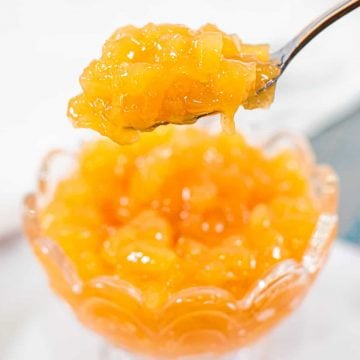
Pineapple Topping for Cakes and Desserts
For best results, use the metrics measurements. US customary measurements have not been tested and are only meant for guide.
Ingredients
Pineapple Topping with Fresh Pineapple
- 275 g pineapple (approximately one small fruit)
- 250 ml water
- 75 g white sugar
- 2 teaspoon lemon juice
- ½ tablespoon cornstarch (mix with 1 tablespoon water)
Pineapple Topping with Canned Pineapple
- 275 g canned pineapple (approximately one can of pineapple with the syrup drained)
- 125 ml pineapple syrup (from the canned pineapple)
- 125 ml water
- 75 g white sugar
- 2 teaspoon lemon juice
- ½ tablespoon cornstarch (mix with 1 tablespoon water)
Instructions
Pineapple Topping with Fresh Pineapple
- Peel and cut the pineapple into cubes.
- Place the cubes in a food processor. Pulse to chop the fruits into smaller pieces.
- Transfer into a medium saucepan
- Add water, sugar, and lemon juice.
- Cook the chopped pineapple over low to medium heat, stirring constantly.
- Once the mixture starts to simmer, turn the heat to low. Continue cooking until it has thickened slightly. Add the cornstarch (mixed with water). Mix well quickly and thoroughly.
- Continue to cook until the topping thickens further.
- Remove from heat and let it cool completely before using.
- Keep the filling refrigerated if not used.
Pineapple Topping with Canned Pineapple
- Drain the canned fruits.
- Place them in a food processor and pulse to chop them into smaller pieces. If using crushed pineapple, skip this step.
- Transfer the processed pineapple into a medium-sized pan.
- Add the syrup, lemon juice, water and sugar.
- Turn on the heat to medium low and cook until the topping starts to simmer. Turn the heat to low and continue cooking until the mixture thickens slightly.
- Add the cornstarch (mixed with water) and mix well, quickly and thoroughly.
- Continue to cook over low heat until the topping reaches the desired consistency.
- Remove from heat and let it cool completely before using.
- Keep the pineapple topping refrigerated if not used.
Notes
-
- This pineapple topping is made using white sugar. You can always substitute it with brown sugar is you wish. Substitute with the same amount. Do take note that brown sugar will result in your pineapple topping to be of a brown hue and white sugar will keep it yellow.
- The taste of canned pineapple is more consistent as they are soaked in sugar syrup compared to fresh pineapple. If you are using fresh pineapple, choose a fruit that is well ripened. A not-so-well ripe fruit will be more sour and taste somewhat bland.
- Regardless of whether you are using fresh pineapple or the canned version, pineapple chunks do not generally soften easily with cooking. Hence you will notice that I have used quite a lot of liquid (water or syrup) in making this fruit topping. The water helps the fruits simmer longer and that helps to soften them better.
- Fresh pineapple is often a lot firmer compared to the canned version. Hence, given the same cooking time, you will find that the topping made using canned pineapple is softer than that made using fresh pineapple.
- There is no difference in the amount of sugar used for the topping made with fresh pineapple and canned pineapple. Despite the canned pineapple being soaked in sugar syrup, it still requires sugar to be added to it when making the topping for best results.
- Cornstarch slurry (mixture of cornstarch and water), if not used immediately will cause the cornstarch to settle into a layer at the bottom of the container. Mix it properly again before using.


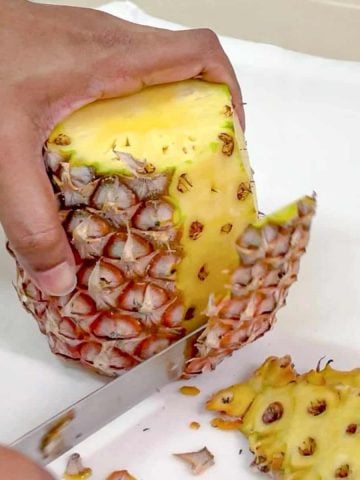
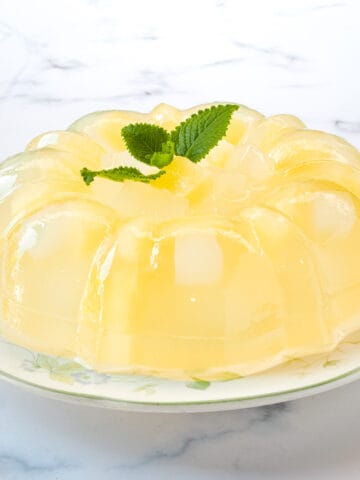
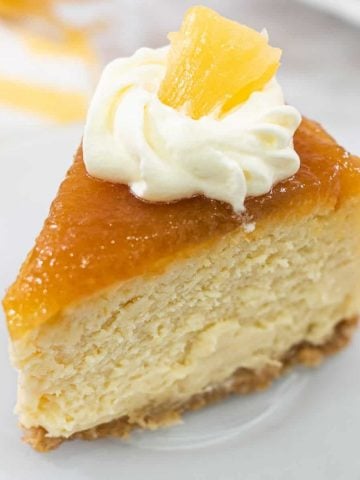

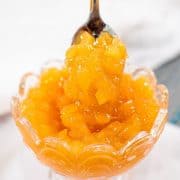
Joana
Could you substitute rum for the water in this recipe? Would that change the amount of liquid used?
Priya Maha
Hi Joana,
I have never tried using rum in the recipe.